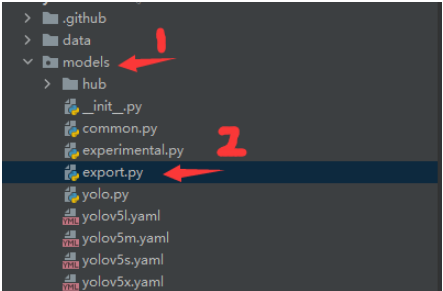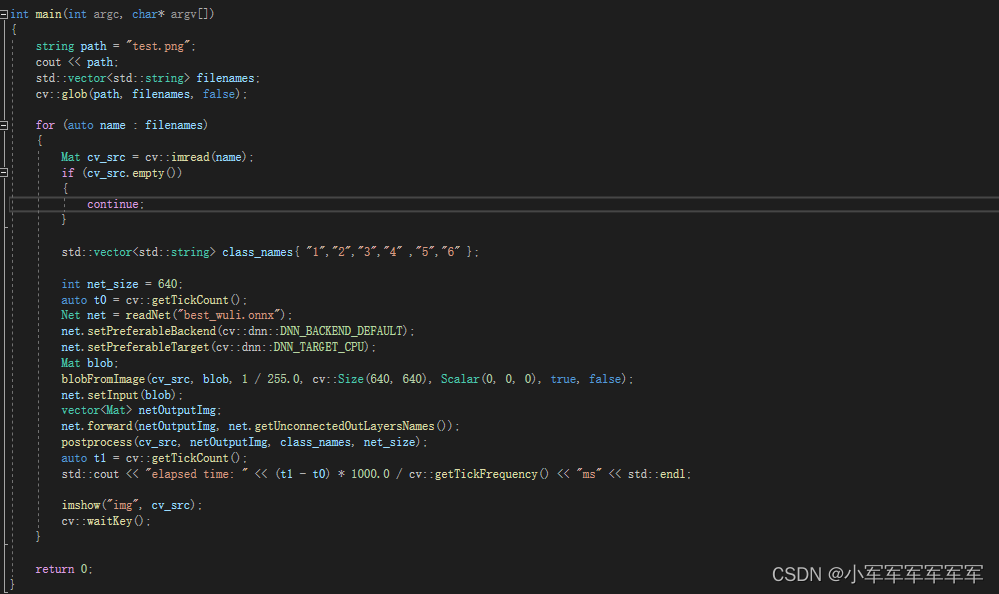本篇内容介绍了“c++如何实现yolov5转onnx”的有关知识,在实际案例的操作过程中,不少人都会遇到这样的困境,接下来就让小编带领大家学习一下如何处理这些情况吧!希望大家仔细阅读,能够学有所成!
训练部分根据呼声再决定要不要写一份博客吧!!
注意事项:
1.训练代码一定要选择yolov5 5.0版本
2. 进入models/exprort.py;

3.将红框区域换成你自己的训练完的模型

4.将版本换成12;

5.直接运行即可,会生成出onnx的模型出来。
博主使用的是opencv4.5.3版本,已经编译好的,需要直接扫码加我发你

读取模型利用的是dnn::readNet,opencv其实挺强大的博主已经读过tf模型,torch模型后续都会出对应博客,这里总共有三点改,输入图片path,输入类别名class_names,net部分改成自己的模型
net.set这些参数都固定就好,有兴趣的同学可以研究研究DNN_TARGET_CPU这个地方,是可以使用gpu和cuda的,但是博主还没复现过
void postprocess(cv::Mat& cv_src, std::vector<cv::Mat>& outs, const std::vector<std::string>& classes, int net_size)
{
float confThreshold = 0.1f;
float nmsThreshold = 0.1f;
std::vector<int> classIds;
std::vector<float> confidences;
std::vector<cv::Rect> boxes;
int strides[] = { 8, 16, 32 };
std::vector<std::vector<int> > anchors =
{
{ 10,13, 16,30, 33,23 },
{ 30,61, 62,45, 59,119 },
{ 116,90, 156,198, 373,326 }
};
for (size_t k = 0; k < outs.size(); k++)
{
float* data = outs[k].ptr<float>();
int stride = strides[k];
int num_classes = outs[k].size[4] - 5;
for (int i = 0; i < outs[k].size[2]; i++)
{
for (int j = 0; j < outs[k].size[3]; j++)
{
for (int a = 0; a < outs[k].size[1]; ++a)
{
float* record = data + a * outs[k].size[2] * outs[k].size[3] * outs[k].size[4] +
i * outs[k].size[3] * outs[k].size[4] + j * outs[k].size[4];
float* cls_ptr = record + 5;
for (int cls = 0; cls < num_classes; cls++)
{
float score = sigmoid(cls_ptr[cls]) * sigmoid(record[4]);
if (score > confThreshold)
{
float cx = (sigmoid(record[0]) * 2.f - 0.5f + (float)j) * (float)stride;
float cy = (sigmoid(record[1]) * 2.f - 0.5f + (float)i) * (float)stride;
float w = pow(sigmoid(record[2]) * 2.f, 2) * anchors[k][2 * a];
float h = pow(sigmoid(record[3]) * 2.f, 2) * anchors[k][2 * a + 1];
float x1 = std::max(0, std::min(cv_src.cols, int((cx - w / 2.f) * (float)cv_src.cols / (float)net_size)));
float y1 = std::max(0, std::min(cv_src.rows, int((cy - h / 2.f) * (float)cv_src.rows / (float)net_size)));
float x2 = std::max(0, std::min(cv_src.cols, int((cx + w / 2.f) * (float)cv_src.cols / (float)net_size)));
float y2 = std::max(0, std::min(cv_src.rows, int((cy + h / 2.f) * (float)cv_src.rows / (float)net_size)));
classIds.push_back(cls);
confidences.push_back(score);
boxes.push_back(cv::Rect(cv::Point(x1, y1), cv::Point(x2, y2)));
}
}
}
}
}
}
std::vector<int> indices;
cv::dnn::NMSBoxes(boxes, confidences, confThreshold, nmsThreshold, indices);
for (size_t i = 0; i < indices.size(); i++)
{
int idx = indices[i];
cv::Rect box = boxes[idx];
drawPred(classIds[idx], confidences[idx], box.x, box.y,
box.x + box.width, box.y + box.height, cv_src, classes);
}
}抬头部分是两大目标检测的阈值设置,然后anchors这些都不建议动,除非你在训练的时候用了你自己生成的anchors的话,就改成你自己的,然后根据训练推理后,会生成我们所对应的坐标框以及分数,将分数和狂送到容器中,dnn中有nms等底层函数哦
cv::dnn::NMSBoxes(boxes, confidences, confThreshold, nmsThreshold, indices);
对应输入就可以了,然后得到我们的Box,index,和置信度,接下来就到了我们的画图环节。
void drawPred(int classId, float conf, int left, int top, int right, int bottom, cv::Mat& frame,
const std::vector<std::string>& classes)
{
cv::rectangle(frame, cv::Point(left, top), cv::Point(right, bottom), cv::Scalar(0, 255, 0), 3);
std::string label = cv::format("%.2f", conf);
if (!classes.empty()) {
CV_Assert(classId < (int)classes.size());
label = classes[classId] + ": " + label;
}
int baseLine;
cv::Size labelSize = cv::getTextSize(label, cv::FONT_HERSHEY_SIMPLEX, 0.5, 1, &baseLine);
top = std::max(top, labelSize.height);
cv::rectangle(frame, cv::Point(left, top - round(1.5 * labelSize.height)), cv::Point(left + round(1.5 * labelSize.width), top + baseLine), cv::Scalar(0, 255, 0), cv::FILLED);
cv::putText(frame, label, cv::Point(left, top), cv::FONT_HERSHEY_SIMPLEX, 0.75, cv::Scalar(), 2);
}inline float sigmoid(float x)
{
return 1.f / (1.f + exp(-x));
}“c++如何实现yolov5转onnx”的内容就介绍到这里了,感谢大家的阅读。如果想了解更多行业相关的知识可以关注亿速云网站,小编将为大家输出更多高质量的实用文章!
亿速云「云服务器」,即开即用、新一代英特尔至强铂金CPU、三副本存储NVMe SSD云盘,价格低至29元/月。点击查看>>
免责声明:本站发布的内容(图片、视频和文字)以原创、转载和分享为主,文章观点不代表本网站立场,如果涉及侵权请联系站长邮箱:is@yisu.com进行举报,并提供相关证据,一经查实,将立刻删除涉嫌侵权内容。